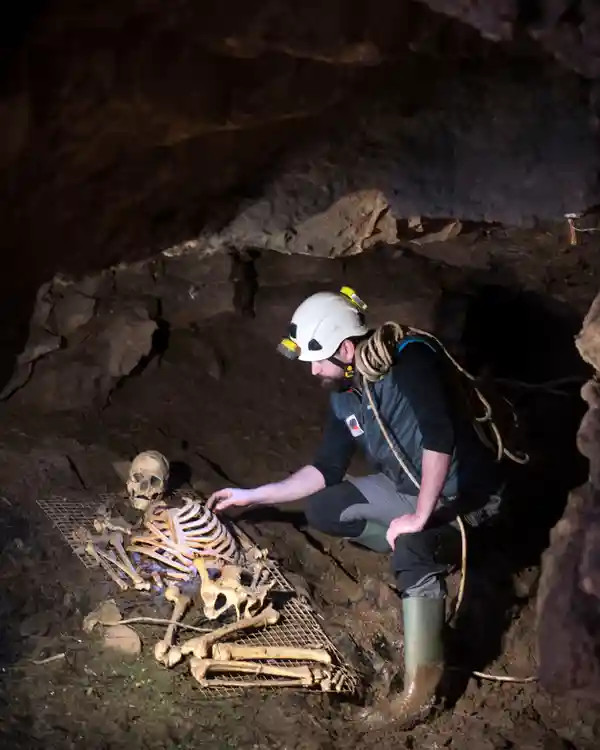In the rolling hills of Somerset, England, a groundbreaking discovery was made in 1903 that has forever changed our understanding of ancient Britain. Unearthed in Gough’s Cave, the nearly complete skeleton of a man, later named “Cheddar Man,” provided an unprecedented glimpse into life 10,000 years ago. Little did the excavators realize at the time that this find would rewrite much of what we know about Britain’s earliest inhabitants.
A Startling Revelation
For decades, scientists believed that early Europeans quickly evolved pale skin to adapt to lower sunlight levels in northern climates. This adaptation was thought to enable better absorption of vitamin D in regions with less sunlight. However, when researchers extracted and analyzed Cheddar Man’s DNA, the results were startling. Genetic markers revealed that this Mesolithic individual had dark skin, closer in tone to that of sub-Saharan Africans, combined with striking blue eyes. This revelation shattered long-held assumptions about the appearance of Europe’s early inhabitants and highlighted the complex interplay between genetics, environment, and human migration.

Life in Ancient Britain
Cheddar Man lived during the Mesolithic period, a time when Britain was still connected to continental Europe by land bridges. This era was marked by significant environmental changes as the last Ice Age receded. Dense forests began to cover the landscape, and the inhabitants relied on their ingenuity to thrive in this evolving world. As a hunter-gatherer, Cheddar Man would have depended on his skills to hunt animals such as red deer and aurochs, a now-extinct species of large wild cattle. Additionally, he and his community would have foraged for seeds, nuts, and other edible plants within the lush forests that dominated the region. This lifestyle required a deep understanding of nature and resourcefulness to survive the challenges of a harsh and changing environment.
A Mysterious Burial
One of the most intriguing aspects of Cheddar Man’s story is his burial. Unlike many of his contemporaries who were interred in communal burial sites, Cheddar Man’s remains were found alone in Gough’s Cave. This unusual treatment has raised questions about his status within his community or the circumstances surrounding his death. Was he a revered figure given a special burial, or did his solitary grave indicate an outcast or victim of unusual circumstances? While the true reason remains unknown, the discovery has sparked endless speculation and fascination.
Reconstructing the Past
The Power of Ancient DNA
Cheddar Man’s DNA owes its preservation to the cool, stable conditions of Gough’s Cave and the protective mineral deposits that encased his remains. Advances in technology allowed scientists to extract and analyze this ancient genetic material with remarkable precision. These analyses not only revealed his physical traits but also provided insights into his diet, health, and genetic lineage. The findings confirmed that Cheddar Man belonged to a population of hunter-gatherers that had migrated to Britain from the European continent, offering a clearer picture of the movement and interaction of early human groups.
Bringing Cheddar Man to Life
Armed with genetic data, scientists and artists collaborated to create a detailed, lifelike reconstruction of Cheddar Man. Using advanced forensic techniques, they sculpted a model of his face, incorporating features dictated by his DNA. The result was a striking image: a dark-skinned man with piercing blue eyes and curly black hair. This reconstruction not only humanized Cheddar Man but also challenged preconceptions about early Europeans, inviting viewers to rethink stereotypes about race and ancestry.
Lessons from the Past
Cheddar Man’s story is a powerful reminder of the fluidity of human traits over time. It underscores the fact that characteristics such as skin color, eye color, and even genetic markers associated with certain populations can shift dramatically due to environmental pressures, migration, and other factors. This discovery challenges modern notions of race and ancestry, showing that the traits we associate with specific groups today may not align with those of their ancient counterparts.
The discovery of Cheddar Man also highlights the resilience and adaptability of the human species. His existence during a time of profound environmental change demonstrates the resourcefulness and ingenuity required to survive in a challenging and unpredictable world. As we learn more about our ancient ancestors, we gain a deeper appreciation for the diversity and interconnectedness of humanity throughout history.
Cheddar Man’s Legacy
Today, Cheddar Man’s legacy extends beyond the confines of Gough’s Cave. He serves as a symbol of the dynamic and ever-changing nature of human history. His story reminds us that the past is not a static record but a complex tapestry woven from countless individual lives, each contributing to the larger narrative of our species.
The revelations gleaned from Cheddar Man’s DNA continue to influence our understanding of human evolution and migration. They have prompted scientists to reexamine other ancient remains, applying similar techniques to uncover new truths about our shared history. These findings not only reshape our view of the past but also inspire us to think more broadly about identity, diversity, and the factors that unite us as a species.
As we uncover more secrets from our ancient ancestors, we are reminded of the importance of preserving and studying archaeological sites. Each discovery, like that of Cheddar Man, adds a piece to the puzzle of our collective past. By exploring these stories, we gain a richer understanding of what it means to be human and a deeper appreciation for the remarkable journey that has brought us to where we are today.
In the rolling hills of Somerset, where Cheddar Man once roamed, his story endures as a testament to the enduring quest for knowledge. It serves as a bridge between the ancient and the modern, connecting us to a time long before written history. Through the lens of science and the artistry of reconstruction, Cheddar Man has been brought to life once more, reminding us of the shared humanity that binds us across millennia. His story is not just about the past but also about how we see ourselves and our place in the ever-evolving story of the human race.





